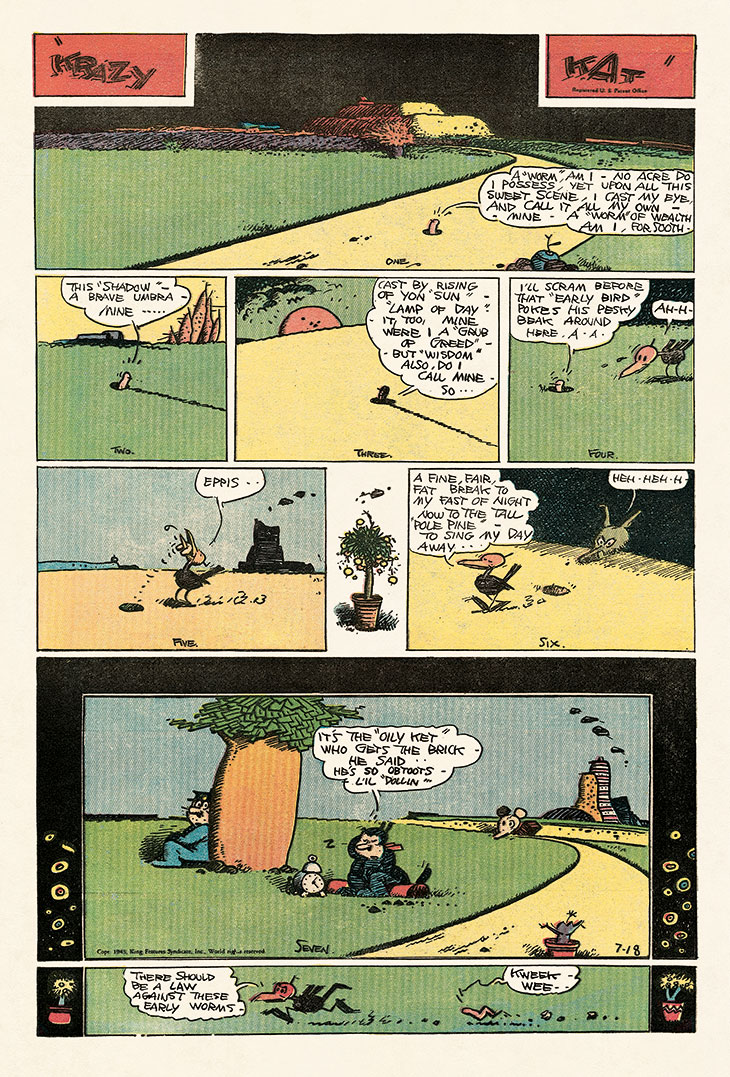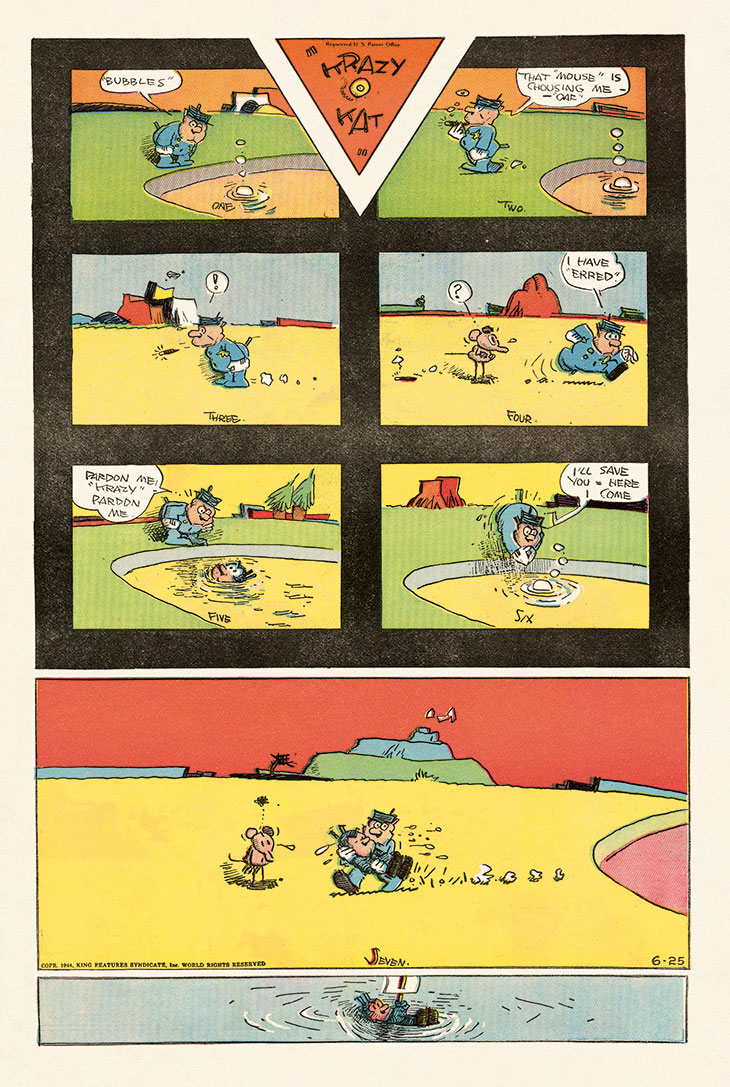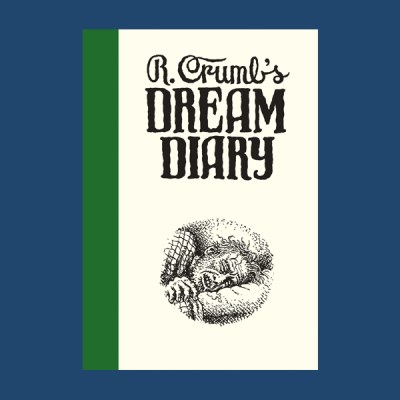Krazy is a simple black cat who leads a serene life of napping, playing music, and wandering the idyllic plains of Coconino County in Arizona. Except, that is, for when he is being subjected to a sustained campaign of brutality. Bricks are regularly hurled at the cat’s head by a pale pink mouse called Ignatz. Krazy doesn’t mind though, seeing it as an expression of love from Ignatz. Officer Pupp never does understand this and the law-enforcing bulldog makes it his life’s work to arrest Ignatz for each attack, the only way he can respond to this bizarre situation.
This simple premise was the basis of Krazy Kat, a comic strip created by George Herriman in the early 1910s, which by 1935 had found its way in to colour comic supplements of the Sunday editions of William Randolph Hearst’s various newspapers across the US. These ‘Sundays’ have been collected together in George Herriman’s ‘Krazy Kat’: The Complete Color Sundays 1935–1944, which is introduced at great length by Alexander Braun.
George Herriman, probably 1930s. Photo: © International Museum of Cartoon Art Collection, The Ohio State University Billy Ireland Cartoon Library & Museum

The comic counted E.E. Cummings, Picasso and De Kooning among its fans. However, it was never widely popular in its time. As the comics historian Bill Blackbeard said of the initial reception of the Krazy Kat strips, ‘they may well have been fed to the Addams Family’s pets: the reaction they elicited was zero. Absolutely nonexistent. This had never befallen a new Hearst comic before.’ It seems only William Randolph Hearst’s personal support of it kept Herriman employed and allowed him to go on producing something which at times is ambiguous and abstruse, while also full of charm and sensitivity.
The language, which is florid and offers no easy understanding, might have been a bit too much for the majority of newspaper comic readers. But once you’ve eased in, it adds depth to scenes in which not a lot really happens. ‘Sunday July 18, 1943’ has a small worm poking its head out of the ground: ‘A “worm”, am I – no acre do I possess, yet upon all this sweet scene, I cast my eye, and call it all my own – mine – a “worm” of wealth am I, for sooth.’ The worm continues to extoll the beauty of the scene as the ‘lamp of day’ rises over the next few cells, before a bird creeps up on it and eats it. It’s a sad end for the worm, but in its few cells it is shown as a sensitive creature who lived a full life. Later in the strip Ignatz is seen creeping up on Krazy, who sits on a log half asleep waiting for Ignatz to brick him, murmuring: ‘It’s the “oily ket” who gets the brick – he said… he’s so obtoots – l’il “dollin”.’
George Herriman’s Krazy Kat, Sunday page from 18 July 1943

Although this is not something Herriman made clear at any point, there are instances of what appears to be political or social commentary. On 21 May in 1944, a brown weasel, Mr W. Weasel, is taken to a beauty parlour by Ignatz. He comes out, in Ignatz’s words, ‘a blonde beauty – pale moon sheen – white hibiscus – fair flower’; or, as he describes himself, ‘a bleached “weasel”’. All of this is because, as Officer Pupp informs him, as a brown weasel the insurance company would consider him a ‘poor “risk”’, but as a white weasel he would be ‘worth a fortune’. ‘Fency a color makin’ a diffince in its welue,’ muses Krazy.
In 1971, 27 years after Herriman’s death, when the sociologist Arthur Asa Berger sent off for the cartoonist’s birth certificate it was found that he was listed as ‘colored’. When Herriman was young his family moved away from New Orleans and started afresh in Los Angeles, where they didn’t tell anyone about their mixed-race heritage; Herriman, who was able to ‘pass’ as white, lived his whole life with this secret. If he hadn’t, this would have either prevented or seriously hindered Herriman from receiving the education he did, working for a newspaper, marrying his wife Mabel, who was white, or living in the areas of LA in which he and his family ended up.
George Herriman’s Krazy Kat, Sunday page from 25 June 1944

This discovery of the birth certificate only added to the mystique of Krazy Kat. Was it in any way autobiographical? The final two published strips seem to hint that there was something of Herriman in Krazy. Now aged 63, and suffering from multiple ailments and serious pain, Herriman was conscious that the end of his life was nearing and making arrangements for his estate – he may also have been thinking about how to wrap up Krazy’s story. On 18 June in 1944 Officer Pupp and Ignatz stand on the shore of a lake.‘That dear “Krazy Kat” is under there,’ says Pupp; ‘I know it,’ says Ignatz. They both dive in; Ignatz, having either known all along or realising later that Krazy wasn’t in the water, swims ashore, leaving Pupp confused in the middle of the lake. The following week’s strip has Pupp inspecting some bubbles in the lake, before deciding that Ignatz is trying to trick him and walking off. When he encounters Ignatz on land, he runs back to the lake to find Krazy’s head poking out of the water. The cat sinks from view and the last frame has Pupp carrying a silent Krazy from the lake past a stunned Ignatz, who has a black scribbled cloud over his head. Pupp stares out at the reader. It seems that, in copying Ignatz and Pupp, Krazy has drowned. This was the final Krazy Kat Herriman ever filed; he died from liver failure two months before it was published.
Why would Krazy enjoy being bricked by Ignatz? And why does Ignatz, who at times seems to be a good friend to Krazy, enjoy throwing a brick at him? It’s a frustrating plot line – never properly explained, it has more than a hint of the absurd. For this reader at least, the bafflement of this premise is just one reason that Krazy Kat begs to be returned to, again and again.
George Herriman’s ‘Krazy Kat’: The Complete Color Sundays 1935–1944, by Alexander Braun, is published by Taschen.



